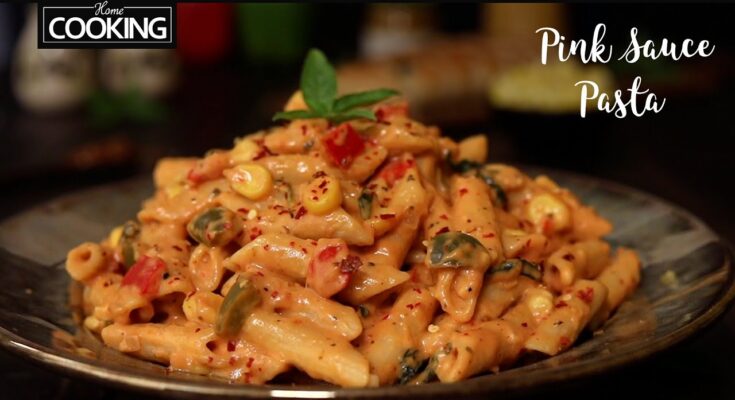Penne Pasta Recipe: Who doesn’t love a warm, cheesy, and flavorful plate of pasta? Penne pasta is a classic that never fails to impress.
Whether you’re a beginner in the kitchen or a seasoned cook looking for a comforting go-to meal, this easy penne pasta recipe will hit the spot.
In this guide, we’ll walk you through every step — from boiling the pasta perfectly to creating a rich, flavorful sauce. Grab your apron and let’s dive into some delicious Italian cooking!
Why Penne Pasta Is a Favorite
Penne pasta is one of those pantry staples that’s always ready to save the day. What makes penne so popular is its unique shape — the short tubes with diagonal ends are ideal for catching and holding onto sauces, making every bite incredibly flavorful. Unlike spaghetti or fettuccine, which often let sauce slide off, penne acts like a sponge, soaking up every drop of deliciousness.
It’s also easy to eat, less messy than long noodles, and universally loved by both kids and adults. Whether you’re making a weeknight dinner, preparing a meal for a potluck, or whipping up a romantic dinner for two, penne is your best friend in the pasta world.
Versatility in the Kitchen
Penne pasta is incredibly versatile. You can toss it in a creamy Alfredo sauce, stir it into a tangy tomato base, or simply drizzle it with olive oil and herbs. It works well with meats like chicken, sausage, and beef — or you can keep it vegetarian with mushrooms, spinach, and bell peppers.
You can also bake it with layers of cheese for a bubbly pasta bake, or serve it cold in a pasta salad. The options are endless, and that’s the beauty of it.
Ingredients You’ll Need
Core Ingredients
Let’s start with the basics. For a classic penne pasta dish that serves 4, you’ll need the following ingredients:
- Penne pasta – 12 oz (around 340 grams)
- Olive oil – 2 tablespoons
- Garlic – 3 cloves, minced
- Onion – 1 medium, finely chopped
- Tomatoes – 4 medium ripe tomatoes (or 1 can of crushed tomatoes)
- Salt – to taste
- Black pepper – to taste
- Italian seasoning – 1 teaspoon
- Basil leaves – a handful, chopped
- Grated Parmesan cheese – ½ cup
These ingredients form the foundation of your pasta. The garlic and onions add aroma and depth, while the tomatoes provide the rich base of your sauce. The seasoning brings it all together for that Italian-style taste.
Optional Add-ons and Variations
Want to take it up a notch? Here are some tasty additions:
- Protein – grilled chicken, Italian sausage, or shrimp
- Vegetables – bell peppers, zucchini, spinach, mushrooms
- Spices – red chili flakes for a spicy kick
- Cream – to make it a creamy tomato sauce
- Mozzarella – for a cheesy melt on top
These options make your penne pasta more exciting and can help customize it to suit your taste preferences.
Tools and Equipment Required
Kitchen Essentials for Cooking Pasta
You don’t need fancy equipment to make penne pasta. Here’s what you’ll need:
- Large pot – for boiling the pasta
- Colander – to drain the pasta
- Wooden spoon – to stir without scratching your pan
- Knife and chopping board – for prepping your veggies
- Measuring spoons/cups – for accurate seasoning
Boiling pasta is simple, but having the right tools helps make the process smooth and hassle-free.
Tools to Make the Sauce Perfect
To prepare a rich and well-balanced sauce, keep these handy:
- Non-stick pan or skillet – for sautéing the sauce ingredients
- Ladle or spoon – to transfer pasta water if needed
- Grater – for fresh Parmesan cheese
- Tongs – for tossing the pasta into the sauce evenly
These simple tools can elevate your cooking, ensuring every element of your dish turns out perfectly.
Step-by-Step Penne Pasta Recipe
Step 1: Boil the Pasta to Perfection
First things first — let’s cook the penne pasta just right. Here’s how to do it:
- Bring a large pot of water to a rolling boil. You want plenty of water so the pasta doesn’t stick together.
- Add a tablespoon of salt. This seasons the pasta while it cooks.
- Add the penne pasta. Stir occasionally to prevent sticking.
- Boil for 10–12 minutes (or check the package instructions). You’re aiming for al dente — tender but with a slight bite.
- Drain the pasta using a colander and toss it with a teaspoon of olive oil to prevent clumping.
Here’s a little trick: reserve about half a cup of the pasta water before draining. This starchy liquid helps bind your sauce to the pasta and adds a silky finish to the dish.
Step 2: Prepare the Sauce
Now comes the heart of any great pasta dish — the sauce. Whether you’re sticking with a classic tomato base or adding a creamy twist, this step is where all the magic happens.
- Heat 2 tablespoons of olive oil in a non-stick skillet over medium heat.
- Add the chopped onions and sauté until translucent — about 5 minutes.
- Stir in the minced garlic and cook for 1–2 minutes until fragrant. Be careful not to burn it.
- Add your tomatoes — fresh or canned crushed tomatoes. Stir them in and let them simmer.
- Season generously with salt, black pepper, Italian seasoning, and a pinch of sugar if your tomatoes are too acidic.
- Let the sauce simmer for at least 15 minutes, stirring occasionally until it thickens.
If you’re going the creamy route, now’s the time to stir in ¼ cup of heavy cream or a tablespoon of cream cheese. Want more heat? Add red pepper flakes. This is your moment to make the sauce yours.
Once the sauce is thick and fragrant, taste and adjust the seasoning. You’re looking for balance — a tangy, savory, and slightly sweet finish.
Step 3: Mix and Simmer
This is where everything comes together beautifully.
- Add the cooked penne pasta directly into your sauce.
- Toss everything gently, making sure the sauce coats each piece of pasta thoroughly.
- If the sauce feels too thick, add a splash of reserved pasta water — this loosens it up and helps the sauce cling better.
- Let the pasta and sauce simmer together for 2–3 minutes. This allows the flavors to marry and soak into the pasta.
At this point, your kitchen probably smells amazing. The pasta should look glossy and coated — not swimming in sauce, but not dry either. You want that perfect harmony of texture and flavor.
For an extra punch, add some freshly chopped basil and a handful of Parmesan cheese. Stir until the cheese melts into the sauce. That final touch brings richness and a slightly nutty kick that’s hard to resist.
Step 4: Serve and Garnish
Time to plate up and impress!
Spoon your hot penne pasta into shallow bowls or plates. Top it off with:
- A sprinkle of grated Parmesan
- A few fresh basil leaves
- A drizzle of olive oil for that restaurant-style shine
- Optional: crushed red pepper flakes for heat
You can also serve it with a side of garlic bread or a crisp Caesar salad to round out the meal. Don’t forget a glass of red wine or sparkling water with lemon for the full Italian experience.
Penne pasta is best served hot and fresh, but you can also pack it in lunchboxes or store it for a later meal. The flavors deepen overnight, making leftovers even more delicious.
Tips for the Best Penne Pasta
Common Mistakes to Avoid
Even the simplest dishes can go sideways. Here are some pasta pitfalls to steer clear of:
- Overcooking the pasta: Always aim for al dente. Mushy pasta ruins texture and soaks up too much sauce.
- Undersalting the water: Pasta water should taste like the sea. It’s your only chance to season the pasta itself.
- Not saving pasta water: That starchy liquid is gold — it emulsifies your sauce and brings everything together.
- Adding cheese too early: It can clump or burn. Add it after turning off the heat.
- Rinsing the pasta: Never rinse after draining! It washes off the starch that helps the sauce stick.
Avoiding these common errors can take your pasta game from meh to magnifico.
Flavor Boosting Secrets
Want your penne pasta to taste like it came straight from a trattoria in Rome? Here’s how:
- Use fresh herbs: Basil, oregano, or parsley bring bright, aromatic flavors.
- Grate your own cheese: Pre-grated Parmesan has fillers. Freshly grated melts better and tastes sharper.
- Toast your spices: Briefly heating your Italian seasoning or chili flakes in olive oil before adding the tomatoes enhances their flavor.
- Deglaze the pan: A splash of white wine or balsamic vinegar in the sauce lifts all the tasty brown bits off the pan for a richer taste.
- Finish with butter: A small pat of butter stirred in at the end gives your sauce a silky finish.
Try any of these next time and taste the difference. Your taste buds will thank you!
FAQs about Penne Pasta Recipe
What type of penne is best for pasta recipes?
The best type of penne for pasta recipes is usually penne rigate. The ridges on penne rigate hold onto sauces better, enhancing the flavor and texture of your dish. However, if you prefer a smoother pasta, penne lisce is a great option.
How much water do I need to cook penne pasta?
For every 100 grams of penne pasta, you should use about 1 liter (4 cups) of water. This ratio ensures that your pasta cooks evenly and doesn’t stick together. Make sure the water is boiling before you add the pasta.
Do I need to add oil to the pasta water?
It’s a common myth that adding oil to the pasta water prevents sticking. Instead, it can actually prevent the sauce from clinging to the pasta properly. Just use plenty of water and stir your pasta occasionally to keep it from sticking.
How long should I cook penne pasta?
Penne pasta typically takes about 11-14 minutes to cook to al dente, which means it’s tender but still firm to the bite. Always check the pasta a minute or two before the indicated time on the package for the best results.
Can I make penne pasta ahead of time?
Yes, you can cook penne pasta ahead of time and store it in the refrigerator for about 3-4 days. To prevent it from sticking, toss it with a little olive oil before storing. When ready to use, just reheat with a bit of sauce or in boiling water.
What are some popular sauces to pair with penne pasta?
Penne pasta is incredibly versatile and pairs well with a variety of sauces. Popular options include marinara, Alfredo, pesto, and arrabbiata. Don’t be afraid to experiment with different ingredients like veggies, meats, and cheeses to find your favorite combination!
Is penne pasta vegan-friendly?
Traditional penne pasta, which is made from wheat flour and water, is vegan-friendly. However, always check the packaging if you’re purchasing from a store as some brands might include additional ingredients like eggs.
How can I make my penne pasta recipe gluten-free?
To make your penne pasta recipe gluten-free, simply substitute the regular penne with a gluten-free variety made from rice, corn, or a blend of gluten-free flours. Make sure to check the cooking instructions as gluten-free pasta can have different cooking times.
What are some creative ways to serve penne pasta?
Get creative by incorporating colorful vegetables, various proteins like chicken or shrimp, and even mixing in different cheeses. You can also bake it in a casserole with layers of cheese and sauce for a comforting meal.
Conclusion
And there you have it — a complete, foolproof penne pasta recipe that’s easy to follow and delicious every time. With just a few pantry staples and a little bit of love, you can whip up a restaurant-quality meal right in your own kitchen. Penne pasta is the kind of dish that never goes out of style, and the best part? It’s endlessly customizable. Whether you’re in the mood for something simple or want to get creative with proteins and veggies, penne pasta adapts beautifully to your cravings.
Cooking at home doesn’t have to be complicated or time-consuming. This recipe proves that with the right techniques and fresh ingredients, you can create meals that are both comforting and impressive. So the next time you’re stuck wondering what to cook, remember: penne pasta is always a good idea.
Buon appetito!



